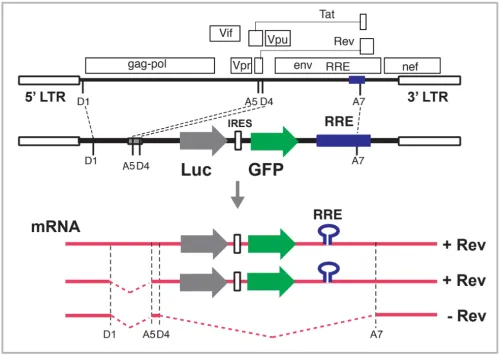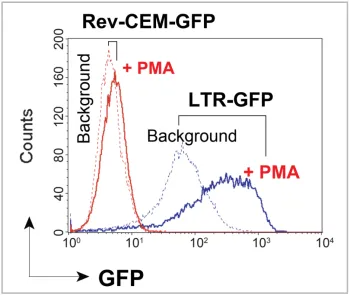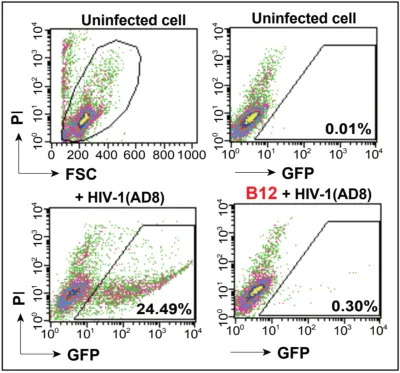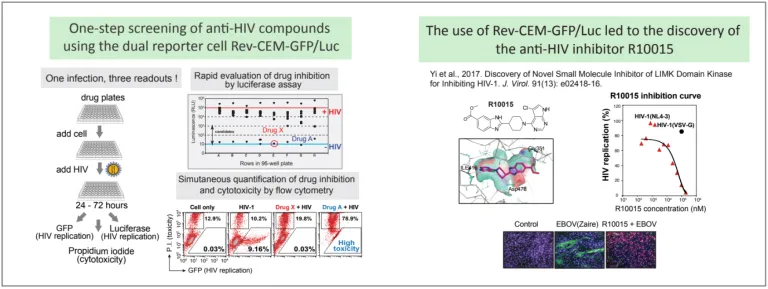Virongy는 바이러스 및 바이러스 벡터 연구를 위한 혁신적인 기술과 제품을 제공하는 미국의 제조업체 입니다.
제품 설명
ExoMaxed™
제품 번호
Cell Type and Reporter
Choose an option:
| Cat. No. | Product |
| RevCell-03 | Rev-A3-GFP/Luc |
| RecCell-01 | Rev-A3R5-GFP |
| RevCell-02 | Rev-A3R5-GFP/Luc |
| RevCell-04 | Rev-CEM-GFP |
| RevCell-05 | Rev-CEM-GFP/Luc |
| RevCell-06 | Rev-CEM-Luc |
제품 설명
The HIV Rev-dependent reporter cells represent a major advancement in the development of HIV indicator cells (Wu et al., 2007). This new reporter system differs dramatically from the common LTR-based reporter cells, which rely solely on the HIV promoter, the long terminal repeat (LTR), to drive reporter expression. While responsive to an early HIV protein, Tat, the LTR is also responsive to cell culture conditions and stimulation by a variety of known and unknown factors, including cytokines, mitogens, HDAC inhibitors, lipopolysaccharide, certain anti-tumor drugs, and free viral proteins (Siekevitz et al., 1987; Sweet et al., 1995). Such non-HIV-dependent reporter expression frequently diminishes reporter specificity and sensitivity. In contrast to the LTR-based reporter cells, our Rev-dependent reporter cells use both LTR and the Rev/RRE interaction to regulate reporter gene expression. This strict requirement for Rev, a viral protein present only in infected cells, drastically improves the reporter specificity and sensitivity. As a result, our Rev-dependent reporter cells are suitable for a broad range of applications, including screening broadly neutralizing antibodies and anti-HIV drugs, and studying HIV cell-cell transmission and host restriction and dependency factors. Derived from CD4 T cells, our reporter cells express native levels of HIV receptors and are natural HIV targets with broad susceptibility to X4, R5, primary HIV isolates, and certain SIV strains. With GFP, Luc, or GFP/Luc detection options, our Rev-dependent cells provide a versatile and flexible platform for HIV research.
Green or Firefly Reporters Available
Have you ever mis-timed your assays only to have all your cells turn blue? Does the X-Gal staining picture look all too familiar? Our Rev-dependent reporter cells eliminate the potential for false positive signals arising because your current indicator cells turned blue without HIV infection or because you did not perfectly time your X-Gal staining. With unparalleled specificity and sensitivity, our Rev-dependent reporter cells come with a GFP, Luciferase, or combination GFP/Luciferase reporter that provides ease of use and flexibility.
 Greater HIV Sensitivity and Specificity – Minimal Background Signal
Greater HIV Sensitivity and Specificity – Minimal Background Signal
Nearly all HIV indicator cells use the LTR promoter to drive reporter expression. While the LTR promoter is responsive to HIV Tat, it generates false positive reporter expression due to HIV-independent factors, resulting in lower HIV specificity and a lower HIV detection range. Changes in cell culture conditions and the presence of mitogens, cytokines, cellular activators, and chromatin modulators can all produce background signal in LTR reporters. Our Rev-dependent reporter cells overcome the drawbacks of LTR reporter lines by being engineered to use the interaction between HIV Rev and RRE (Rev-Response Element) to regulate reporter expression. Rev is present only in HIV+ cells. The high stringency that Rev imposes on the reporter dramatically decreases background signal and significantly increases sensitivity. Thus, our Rev-dependent reporter cells specifically detect low levels of HIV replication even in the presence of environmental factors that generate false signal with the LTR promoter.

Our Rev-dependent reporter cells carry stably integrated reporter constructs that are derived from the HIV genome. The incorporation of RRE and multiple, authentic HIV splicing sites permits reporter expression only from the non-spliced and singly-spliced transcripts in the presence of Rev.
 Our Rev-dependent reporter cells are highly HIV-specific when compared with the LTR-GFP indicator cells. Without HIV, our reporter cells have undetectable GFP, whereas the LTR-GFP cells have high background GFP. Our Rev-dependent reporter cells do not respond to PMA stimulation (100 ng ml-1), while the LTR-GFP cells respond to PMA stimulation by producing high levels of GFP signal in the absence of HIV.
Our Rev-dependent reporter cells are highly HIV-specific when compared with the LTR-GFP indicator cells. Without HIV, our reporter cells have undetectable GFP, whereas the LTR-GFP cells have high background GFP. Our Rev-dependent reporter cells do not respond to PMA stimulation (100 ng ml-1), while the LTR-GFP cells respond to PMA stimulation by producing high levels of GFP signal in the absence of HIV.
Thoroughly Characterized
Each of our cell lines has been thoroughly characterized and validated with regards to HIV responsiveness and sensitivity to anti-HIV inhibitors, HIV activators, and HIV neutralizing antibodies. Our reporter cells are derived from human T cells and carry physiological or near-physiological levels of HIV receptors and relevant T-cell receptors. As such, our reporter cells are especially suited for quantifying HIV isolates and bnABs using laboratory and clinical research samples.
Greater Physiological Relevance
Our Rev-dependent reporter cells are derived from CD4 T cells such as CEM-SS (Wu et al., 2007) and A3R5 (McLinden et al., 2013), and are further engineered with a dual LTR and Rev-dependent reporter system. Because they are derived from CD4 T cells and do not contain a superabundance of HIV receptors, our reporter cells provide a physiologically relevant and nAB-sensitive reporter system.

Receptor cell density of A3R5 cells. Source: PLOS ONE, McLinden et al. 2013, 8: 11, e77756. Our Rev-dependent Cell Lines (derived from CEM-SS & A3.01 cells) do not have a superabundance of receptors and more closely mimic natural T-cell HIV receptor densities.
Examples of Application
Quantification of HIV neutralizing antibodies
 Prior to infection, HIV(AD8), an R5 virus, was incubated with or without the HIV neutralizing antibody B12 (10 μg ml-1 final). After 1 h, Rev-A3R5-GFP cells were infected with Ab-neutralized and non-neutralized virus. Cells were washed and cultured for 48 hours. GFP expression was quantified by flow cytometry. PI = propidium iodide.
Prior to infection, HIV(AD8), an R5 virus, was incubated with or without the HIV neutralizing antibody B12 (10 μg ml-1 final). After 1 h, Rev-A3R5-GFP cells were infected with Ab-neutralized and non-neutralized virus. Cells were washed and cultured for 48 hours. GFP expression was quantified by flow cytometry. PI = propidium iodide.
One Step Anti-HIV Drug Screening with the Rev-dependent GFP/Luc Reporter Cell
Easy to Use: One Infection, Three Readouts. Increase the efficiency of your screening process by simplifying your protocol. With our Rev-dependent reporter cell system, three readouts may be generated with one infection. Easily screen for positive candidates based on the luciferase signal and then obtain population dynamics through flow cytometry based on the fluorescent signal of GFP and/or a vital dye.

The Making of the Rev-dependent Reporter Cells
The HIV Rev-dependent Reporter cell lines were originally developed by Wu & Marsh at the National Institutes of Health. The first generation of the Rev-dependent cell, Rev-CEM, has been used extensively in multiple laboratories for studying HIV infection, anti-HIV drugs, and HIV cell-cell transmission. Multiple Rev-dependent Reporter cells have been developed recently to meet the needs of the HIV/AIDS research community.
HIV Infection of Rev-dependent reporter cells
(When using HIV Rev-dependent Reporter cells, use of HIV InfectinTM is required)
1. Count cells to be infected, and pellet cells by centrifugation at 300 x g for 5 minutes.
Note: Cell viability should be ≥ 80%.
2. Resuspend cells in complete media at a concentration of ~2 x 106 cells ml-1.
3. Use 100 μl of cells (~2 x 105 cells) per infection.
4. Pre-treat cells by adding 10 μl of HIV Infectin (10X) so that the HIV Infectin concentration is 1X. Mix and incubate for 2 hours.
5. Add virus to the cells and mix. Note volume of virus used.
6. Add HIV Infectin in an amount equal to 1/10 of the virus volume used. For example, if 100 μl of virus is used, add 10 μl of HIV Infectin. Incubate at 37°C for 2–4 hours.
7. Wash cells by adding an additional 1 ml fresh complete media, pelleting cells as in 1) above, and removing supernatant. (Optional) Repeat once for a total of two washes.
8. After washing, resuspend cells in 1 ml complete medium.
9. Culture and utilize cells as usual.

Virongy의 모든 제품을 만나 보세요!
Products
Services
Viral Neutralization Assay Services
PL Bioscience - Official Distributor in South Korea "Morebio" 한국 공식 대리점 "모아바이오"